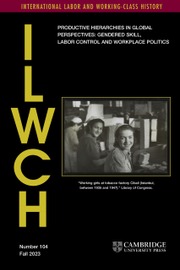Article contents
Gender and Class in the Twentieth Century
Published online by Cambridge University Press: 02 April 2001
Abstract
Few nonspecialists know that Belgium was the first continental Europeancountry to benefit and suffer from the Industrial Revolution. Resulting in partfrom this heritage and also building on an even older tradition of textilemanufacturing dating back to the High Middle Ages, Belgium is home to a numberof high-quality museums and institutions showcasing and researching the age ofindustry and its corresponding social movements. Two such organizations are theArchive and Museum of the Socialist Workers Movement (AMSAB) and the Museum ofIndustrial Archaeology and Textiles (MIAT) in the city of Ghent. On April27–30, 1999, these two institutions joined forces to organize aninternational conference on “Gender and Class in the 20th Century.”For several days, participants from Switzerland, the Netherlands, France, GreatBritain, and Belgium gathered to listen and respond to a variety ofpresentations covering the whole range of issues related to the conferencetheme, from sexuality at the point of production to the discursive constructionof poverty as female in the contemporary global age.
Information
- Type
- Reports and Correspondence
- Information
- Copyright
- © 2000 The International Labor and Working-Class History Society
- 1
- Cited by

